|
|
|
|
|
|
Tools
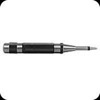 Center Punch |
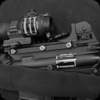 Ballistickers |
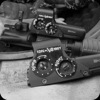 EoStickers |
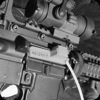 SafePort® |
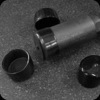 KX3 Caps |
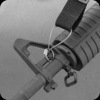 Sling cable |
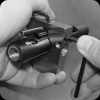 MOACKS |
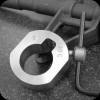 Pocket MOACKS |
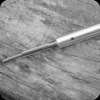 5.56 Reamer |
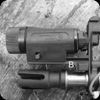 ILM |
Ideal Light Mount
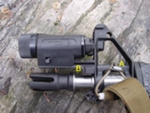
I feel that far and away the best place for a light on one of these is between the bore and the front sight. Fortunately, on the AR there is plenty of room between the two. Why is it better? Well, two things you need to make a shot using a rifle-mounted light are to have the bore clear of, say, a barricade, and to be looking through the sights. If you are doing this and the light is mounted between the two, there can be no problem. With an under-mounted light, you might be using the sights and have the bore clear of the barricade, but now, to get the light clear, you need to come up from cover another three-plus inches. Plus, until you do, if your light is on you may backlight the barricade and lose your night vision temporarily. The same goes for a light that is mounted on the left or right-- it makes side barricade shooting harder. You either step out from behind cover further or flash the back of the barricade.
Also, having it further forward than most mounts is a big advantage in terms of casting a shadow. I've seen plenty of lighting setups where the barrel and flash suppressor are blocking maybe 1/3 of the light being put out. If it's mounted on the right, for example, you'll have a big dark zone on the left, and worse, that dark zone bounces around as you move-- just what you don't need if you're out there lighting things up and looking for movement. Another advantage to the top and forward position is that your light does not light you up as much. Mounted rear and right side again as an example, the front 1/3 of your rifle's right side is painted by your own light, making you very high profile, even to someone behind you on the right.
This position also makes the light a lot more knock-proof. It's not adding to the height or width of the rifle, and it's in a "protected zone"; much less likely to take a beating, or catch and slow you down, going through a door or going prone in a hurry.
The ILM is best suited for one of the smaller lights. I find the SureFire X200 or the Streamlight TLR1 can do most or all of what the bigger lights can do, with the big advantage of being low-weight and low bulk. My personal light philosophy at this time is to have two of these mounted on a rifle, one with a tape switch and one without. This way-- since things can go wrong with the best of lights-- you are sure to have light when you need it, without a big weight and bulk penalty. The ILM as shown is one of several patent-pending versions. This one requires a slight mod to the front sight base and is available at $145 which includes return shipping of your top end or front sight base. Also check out the ILM-JT, which mounts the excellent Streamlight TLR2 upside-down so that the laser is just skimming the top of the barrel, about 5/8" from the center of the bore. This eliminates the point of aim / point of impact concerns with most laser mounting options, which put the laser up to 3" from the bore, and often to one side. Such a setup is nearly impossible to use well: if the laser is 3" from the bore at 1:30, and is zeroed at 10 yards, at 30 yards the point of impact will be 6" off high and right, not to mention that everything from contact to 10 yards will be off low and left by up to 3". With the ILM-JT zeroed at 15 yards, from contact distance to 15 yards the POI will be no more than 5/8" low. Out to 30 yards it will be no more than 5/8" high. Even at 60 yards, probably further than the laser would be used, the POI would be less than 1 1/4" high. Where the top of the ILM-JT brackets the front sight base, can be drilled for tritium, so attaching the tritium-equipped ILM-JT gives instant night sights without resorting to a tritium-equipped front sight post, which are so wide as to inhibit precision shooting at distance and are much more difficult to adjust for elevation than a standard front sight post. Since shooting with night sights is not going to be a long range affair, the inserts are positioned just a little lower than the tip of the front sight, so that close-up shots are to the point of aim. The inserts are recessed forward so they are for "your eyes only". They are not visible from the sides; someone would have to be literally looking over your shoulder to see them. Two pins protrude from the rear of the ILM-JT at the top, to locate it properly to the front sight base. See picture #68 in the Photo Gallery.
$160 installed on your front sight base.